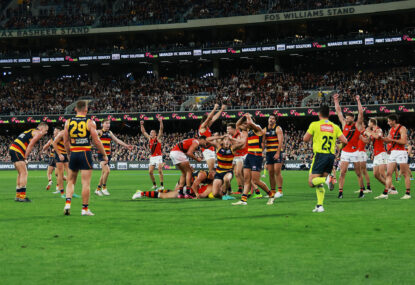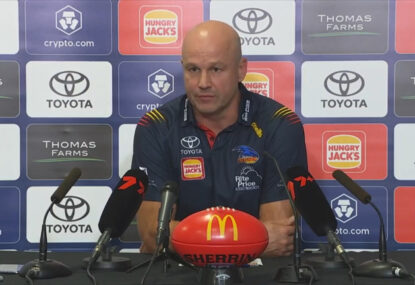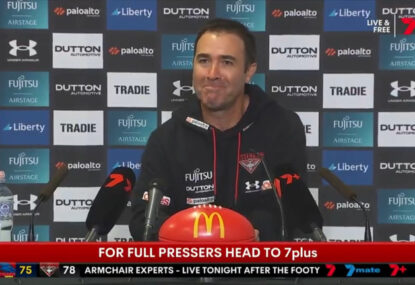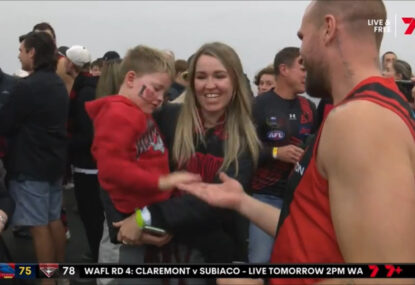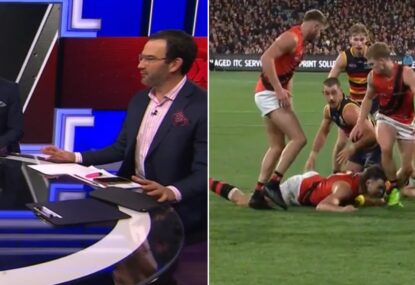It’s hard to know what to make of last week’s rolling developments in the volatile world of sports doping investigations.
One reason for holding fire is that the furious reactions to news on the subject have long ceased to be a reliable indication of anything more than a propensity for furious reactions to news on the subject.
Another is that the volte-face by the Australian Sports Anti-Doping Authority doesn’t appear to be all that outrageous.
Earlier reports that ASADA would not be pursuing former Gold Coast defender Nathan Bock over a possible 2010 doping violation came as no surprise to Essendon loyalists, embittered by what they regard, with some justification, as the disproportionate targeting of their club.
Later reports that the anti-doping authority had reconsidered its position and now would be pursuing Bock for a possible violation also came as no surprise to the disaffected Bomber diehards.
Rumours at the weekend that further developments may be afoot haven’t been substantiated, but word in the underground is that, whatever fresh outrages do emerge, it’ll come as no surprise to at least one group of interested onlookers (you read that here first).
ASADA’s change of tack followed a Herald Sun report that Stephen Dank had admitted to providing the banned peptide CJC 1295 to Bock in the summer of 2010-11.
The “admission” was made to a Herald Sun journalist, Michael Warner, so we can probably assume that extracting it didn’t involve Camp X-Ray interrogation techniques. And you’d need to have done something pretty heinous in a past life to be convicted on Dank’s evidence in this one.
The timely reheating of other old revelations is neither coincidental nor conclusive. True, ASADA’s top brass decided not to act on advice from its investigators in 2013 that the case against Bock was strong enough to prosecute. Yes, Dank’s former sidekick, Dean Robinson, said he showed the expansion-club recruit how to self-administer the peptide in 2010.
That’s two arrows pointing in one direction among 200 pointing in a lot of directions, and 2000 more pointing nowhere. It’s not enough to round up a grand jury.
But line them up with ASADA’s vacillations of last week and an invincible either-or-both case practically makes itself.
Either ASADA pursued Essendon on the scent of blood and a series of hunches, or it was too incompetent to make a no-brainer against Bock. Either it was bad faith, bad management, or both. To the beleaguered true believers, of course, it was all of those things. And the effing rest!
No surprises there. Why do you think they’ve adopted Radiohead’s least-okay single as their unofficial club jingle? It beats climbing up the walls.
But it doesn’t prove much, except that pressing the buttons of partisans is still a standard business model for newspapers. Those of us who were foolish enough to read the truckloads of turgid case-related material when it was made available could probably name a hundred details that arguably suggested something, and actually proved nothing.
To get an idea of the eligibility threshold for making an arguable case these days, you only need to look at the people making them. Mark Robinson’s analysis of the legal merits in the Herald Sun was a disorderly mess of impulses and fragments.
Of the World Anti-Doping Authority’s failure to make a drop-everything top priority of investigating a retired AFL journeyman 10,000 miles away, for example:
“This is reprehensible and disturbing from WADA, not least hypocritical.
“It wants to stamp out doping, yet even us with a limited knowledge of what pertains to be strong circumstantial evidence, you’d think Bock would be in serious trouble if WADA appealed. You know, strands and cables and those kinds of thing.”
That’s a direct quote. He can’t even make a decent fist of false-modesty. He may “pertain” to have a limited knowledge of the evidence, but he’s confident enough to volunteer his assessment of the relative strengths of the two cases. Who would rise to that challenge?
Robbo may be a likeable chap (in small doses) but you’d have a less pointless debate about him than with him. He’s one of the leading practitioners in sports media, which is one of the few growth industries in Australia. Parents take out second mortgages so their children can aspire to this sort of excellence. Drugs in sport is the least of our problems, believe me.
Not that legal credentials alone are any antidote to the prevailing malaise. Steven Amendola, the force behind James Hird’s legal triumphs, was hardly less ropable. “I hope people see the bare-faced hypocrisy of ASADA,” he seethed, as though wearing a ski mask or pair of wraparound Anti-Cancer Council sunglasses makes you a lesser hypocrit.
Amendola performs well in hypothetical contests. He never tires of explaining how well his star client was travelling in the cases that didn’t go the distance – the one that was discontinued before trial, or the other one that was settled by consent. They’d have won those with a leg in the air, as Steven tells it.
Unfortunately, the two that did proceed to full hearing and judgment failed about as emphatically as it is possible for two cases to fail. Amendola is better at starting fights than winning them, on the evidence I’ve seen.
Chip Le Grand isn’t necessarily a model of Swiss neutrality either, but he’s regarded as the authority on this particular epic of attrition. And rightly so – no one else can match his command of its broad, sprawling contours. His work for The Australian is a reliable go-to for other media outlets. His book, The Straight Dope, was a formidable achievement.
But big pictures consist of smaller parts and the order of importance Le Grand imposes on the latter doesn’t conform to everyone’s idea of serious purpose. He devoted more pages of his book to a mildly disparaging remark made of him on radio by Andrew Demetriou than to the entire Federal Court trial and appeal, which consumed the second half of 2014 and beyond.
Demetriou’s alleged tip-off to ill-fated Essendon chairman David Evans was also given another exhaustive airing, despite having the same objective importance as the mystery phone caller Robbo still regards as the key to everything. Demetriou was investigated and cleared, by the way.
Like many a sleuth in the golfing classes, Le Grand is more interested in the contradiction than whether it means very much.
Those sidebar courtroom entanglements make for pretty dour reading, but they weren’t of ASADA’s making, and they consumed a lot of resources. Even statutory authorities have limited budgets. ASADA recovered a chunk of its costs by winning the cases, and by the largess of James Hird’s anonymous benefactor.
But it didn’t recover the hundreds of hours spent trawling through the thousands of pages of case authorities and other material that had nothing to do with the main job. Maybe that’s why the Bock file was, as Chip lamented in The Australian last week, “left in a drawer to gather dust”.
Maybe ASADA boss Ben McDevitt isn’t obliged to “respond to a series of questions from The Australian about ASADA’s failure to proceed against Bock and Robinson despite the similarities between what happened at the Gold Coast Suns in late 2010, Cronulla in 2011 and at Essendon in 2012.”
Maybe Chip didn’t specify whether he wanted the 100-page answer or the longer one. Maybe Ben plays golf on Sundays.
Why did ASADA ignore the chance to effect the quick, clean prosecution of one player that its own investigators said was achievable, in favour of a teamwide engagement that had no projected end date? (And still hasn’t.)
Maybe it decided that an injecting extravaganza involving most of a playing list and more chemicals than you could rake from the stormwater drains of Lake Geneva was a pretty serious thing. Maybe it punted on Bock not going on to achieve Lance Armstrong-like dominance in his chosen sport – he was all-but retired by then, after all.
Why the conflicting explanations for not charging Bock? Why cite the published reasons of a decision that was overturned, and you disagreed with anyway. Why the change now?
I don’t know, Chip. Why do you ask? ASADA is a prosecutor, not an arbitrator. It’s not what McDevitt believes that matters, it’s whether he can make a tribunal believe it.
Don’t worry, there was never any conspiracy to spare Bock or Gold Coast. ASADA needs all the wins it can get. It will consider the direct witness evidence that apparently only came to light for the first time last week. I dare say it would be more confident if the direct witnesses were Cate Blanchett and Roger Federer rather than the two stand-up guys the sportswriters are happy to place their trust in. But it will have a look.
Speaking of inconsistencies, indeed speaking of the Swiss, I’m not convinced of the logic behind the action currently before the Swiss Federal Court. In filing their application for an expedited appeal the players under doping suspension made it known their priority was clearing their names, long term. Paul Marsh of the Players Associoation confirmed the action wasn’t motivated by any realistic hopes of returning to the field in 2016.
Why the urgency then? Why expect the court of another country to put its caseload on hold so as to provide “a level of comfort” to a dozen Australian footballers who don’t expect to play this year anyway? They’ve got one or two other jurisdictional disputes to sort out in that part of the world right now, unless I’m mistaken.
If I was an assistant listing clerk in the cattle-class levels of the Swiss justice bureaucracy I’d be inclined to let that one gather dust in my in-tray a while longer, too. I’d be tempted to list it for mention sometime in the late-fall of 2019.
At some point, the prospects for meaningful vindication are so marginal that the ongoing quest for it is simply an addiction, subject to every addiction’s law of diminishing returns, and diminishing sympathies.
We passed that sign a while back, guys. Let it go before the passport office closes its doors on you for good.
I wrote an article for The Roar on Wednesday (20th April) carried the potentially misleading title of No Surprises, ASADA find no case to answer.
The article was directed at criticisms made of the Australian Sports Anti-Doping Authority over the preceding ten days.
The basis of the initial criticism was the announcement by ASADA that it would not be prosecuting former Gold Coast Suns’ defender Nathan Bock over an alleged breach of the AFL anti-doping rules in 2010-11.
The basis of the further criticism was the subsequent announcement by ASADA that it would reconsider the Bock case in light of new witness evidence that had emerged in the interim.
The new evidence consisted largely of a claim by Stephen Dank that he had supplied Bock with the banned peptide CJC 1295 during the period in question, albeit via a former associate, Dean Robinson.
The substance of my article was that these new developments didn’t necessarily confirm any or all of the various conspiracy theories in circulation.
In short, I concluded that the criticism was exaggerated and that ASADA had no case to answer.
But in my short summary of the story I may have been less than clear in making this point. As a result the title may have given the impression that ASADA had completed its consideration of the new information and found that Nathan Bock had no case to answer.
If so, that is a mistake. A spokesperson for ASADA confirmed on Thursday that consideration of the new information on Bock is ongoing.






























































































